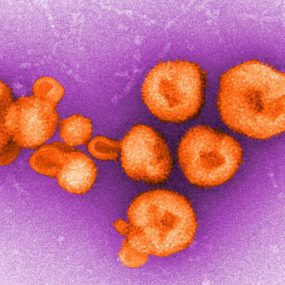
Viral Hemorrhagic Fevers (VHFs)

Virus Families
VHFs are caused by viruses of four distinct families: Arenaviridae, Bunyaviridae, Filoviridae, and Flaviviridae. Each of these families share a number of features:
- They are all RNA viruses, and are all covered, or enveloped, in a fatty (lipid) coating.
- Their survival is dependent on an animal or insect host, called the natural reservoir.
- The viruses are geographically restricted to the areas where their host species live.
- Humans are not the natural reservoir for any of these viruses. Humans are infected when they come into contact with infected hosts. However, with some viruses, after the accidental transmission from the host, humans can transmit the virus to one another.
- Human cases or outbreaks of hemorrhagic fevers caused by these viruses occur sporadically and irregularly. The occurrence of outbreaks cannot be easily predicted.
- With a few noteworthy exceptions, there is no cure or established drug treatment for VHFs.
Arenaviridae
The Arenaviridae are a family of viruses whose members are generally associated with rodent-transmitted diseases in humans. Each virus usually is associated with a particular rodent host species in which it is maintained. Arenavirus infections are relatively common in humans in some areas of the world and can cause severe illnesses.
Bunyaviridae
The Bunyaviridae are a very large family of single-strand, enveloped RNA viruses (more than 300 viruses) and consists of five genera of viruses: Orthobunyavirus, Phlebovirus, Nairovirus, Hantavirus, and Tospovirus (Tospoviruses infect only plants). They are found in and transmitted by arthropods (e.g. mosquitoes, ticks, sand flies) and rodents, and can occasionally infect humans. Several viruses of the Bunyaviridae virus family can produce mild to severe disease in human, in animals, and sometimes in both. This is the base for the requirements of handling some of these viruses in high containment (Biosafety Level 3 or even
